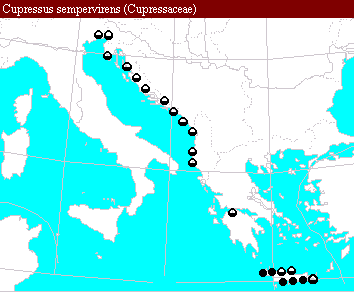 Distribution of C. sempervirens within Europe. Half-black dots indicate uncertain status. Asian and African distribution not shown on this map (10). |
Cupressus sempervirens Linnaeus
Common NamesMediterranean cypress, common cypress, Italian cypress.Taxonomic notesSyn: Cupressus horizontalis (1). "Two typical varieties are known:"var. sempervirens (= C.s. fastigiata Hansen; C.s. var. pyramida1is Nyman; C.s. var. stricta Ait.; C. pyramidalis Targ. - Tozz.) - columnar or narrowly conical habit, with a wide variety of this property. "var. horizontalis (Mill.) Gord. (= C. horizontalis Mill.) - branches broadly spreading, crown broadly conical" (3). It is widely thought that only var. horizontalis predates human activity, with var. pyramidalis having a horticultural origin dating to early historic or prehistoric times. There is some question as to whether the pyramidal form is strictly heritable; it appears that "horizontalis" specimens may arise from "pyramidalis" stock -- but since "wild" var. pyramidalis have been described, it seems likely that both varieties are naturalized within the species' current distribution (8). Description"A tree 20-30 m in height. Trunk straight. Bark thin, smooth and gray for quite a long time, later becoming gray-brown and longitudinally furrowed. Shoots radiating in all directions, about 1 mm in diameter, round or quadrangular. Leaves scale-like, decussate, small, ovate, obtuse, dark green, with a dorsal gland in the shape of longitudinal furrow. Flowers appear early in spring. Cones on short stalk, glossy, brown to gray, pendulous, globose to elliptic, 2-3 cm long, composed of 8 to 14 opposite scales, with concave to flat apophysis, with a small central umbo and a point. Seeds 8-20 to each fertile scale, brown, flattened, minute, without resin blisters, narrowly winged. Cotyledons usually 2" (3).RangeDue to the long horticultural history of this species in the Mediterranean region, its original native distribution is unclear; perhaps the question is pointless, as widespread human alteration of natural environments in the region has occurred across a time span featuring substantial climate changes. Various authorities attribute its native distribution to Greece (some Aegaean islands), Turkey, Crete, N Iran, Lebanon, and Syria; and perhaps Cyprus (which would only be appropriate). In N Africa, it may be native to Tunisia and N Libya. Currently, it can be found growing in cultivation or locally naturalized throughout the entire Mediterranean region (2, 3, 8). "Moreover, the existence of C. atlantica (regarded by many as a subspecies of C. sempervirens) in Morocco and C. dupreziana in Algeria suggests that [N African] stands of unknown origin might be native or might have native ancestors" (8).It is tolerant to temperatures as low as -20°C (4, 9). "This species is also tolerant to drought, air currents, wind dust, sleet and atmospheric gases. Its root system is well developed. It succeeds on acid and alkaline soils" (3). Big TreeThe largest reported specimens within the species' native range can be found in the Lefka Ori (Greek for White Mountains) of Western Crete. In the National Park"Samaria Gorge" trees grow to approximately 30-33 m high and 1 m dbh. These trees may have been planted in ancient times. In native stands a big tree would be some 20-25 m tall and 50 cm dbh (8). The largest trees are probably old horticultural specimens that have received ample water and nutrients. For example, a dbh of 182 cm and height of 15 m are reported for a tree in Campestri, Tuscany (7), and another Tuscan tree (Firenze, FI: Villa della Petraia) has been measured at 30 m tall and 172 cm dbh (8).Oldest"The species attains up to 1000 years of age" (3).DendrochronologyIn Italy, its use has been explored for both archeological dating and dendroclimatic reconstruction (6). It has frequently been used in archeological dating in Israel (e.g., 5).EthnobotanyA common ornamental, planted around the world. The "[w]ood is durable and easily worked" (3), and the species has been planted for timber production, particularly in South America, Africa, and New Zealand (8).ObservationsSee Big Tree, above. Can also be seen in nearly any subtropical or temperate arboretum.Remarks"Cones begin to open in September. After shedding the seeds, the cone persists on the tree for several years. Some cones never open [see below]. Full crop of seed occurs every year. Germination energy is high and germination lasts for several years. Due to aromatic oils, the seeds are fragrant, especially when crushed. In 1 kg there are up to 150,000 seeds."Fast-growing when young, it begins producing seed in its tenth year. In addition to seeds, it may be propagated by grafting, cuttings and coppice shoots" (3). As with most species of Cupressus, C. sempervirens displays varying levels of serotiny: cones may remain unopened on the tree for many years until a fire induces them to open and subsequently to shed viable seed. Citations(1) Silba 1986.(2) Vladimir Dinets, e-mail communications, 12 Jan 1998. (3) Vidakovic 1991. (4) Tucovic, A. 1956. Cempres - Cupressus sempervirens L. u Beogradu. Sumarstvo 1-2: 45-52. (5) Liphschitz, N., Lev-Yadun, S., Waisel, Y. 1981. Dendroarchaeological investigations in Israel (Masada). Israel Exploration Journal 31(3-4): 230-234. (6) Corona, E. 1970. Valore dendrocronologico del cipresso sempreverde. [The value of Cupressus semperivens for dendrochronology.] Monti e Boschi 21(5): 21-25 [in Italian with English summary]. (7) CORPO FORESTALE DELLA STATO, a listing of big trees in Italy. (8) Hristo Dimitrov Stankov, e-mail communication, 30-Jun-1999. (9) P. Raddi and A. Panconesi. 1989. Genetic variability of tolerance to cold in Cupressus sempervirens progenies. Silvae Genetica 38(5-6):168-172. (10) Atlas Florae Europaeae 1998. |
|
[Cupressus] [Cupressaceae] [home] This page is from the Gymnosperm Database
|